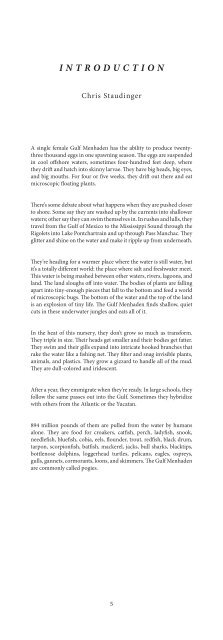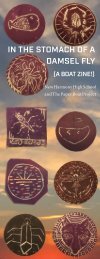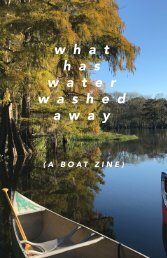Hold The River Banks Up
A boat zine from a writing retreat to Turtle Cove in the Spring of 2018. Designed by Soleil Garneau.
A boat zine from a writing retreat to Turtle Cove in the Spring of 2018. Designed by Soleil Garneau.
You also want an ePaper? Increase the reach of your titles
YUMPU automatically turns print PDFs into web optimized ePapers that Google loves.
INTRODUCTION<br />
Chris Staudinger<br />
A single female Gulf Menhaden has the ability to produce twentythree<br />
thousand eggs in one spawning season. <strong>The</strong> eggs are suspended<br />
in cool offshore waters, sometimes four-hundred feet deep, where<br />
they drift and hatch into skinny larvae. <strong>The</strong>y have big heads, big eyes,<br />
and big mouths. For four or five weeks, they drift out there and eat<br />
microscopic floating plants.<br />
<strong>The</strong>re’s some debate about what happens when they are pushed closer<br />
to shore. Some say they are washed up by the currents into shallower<br />
waters; other say they can swim themselves in. In rushes and lulls, they<br />
travel from the Gulf of Mexico to the Mississippi Sound through the<br />
Rigolets into Lake Pontchartrain and up through Pass Manchac. <strong>The</strong>y<br />
glitter and shine on the water and make it ripple up from underneath.<br />
<strong>The</strong>y’re heading for a warmer place where the water is still water, but<br />
it’s a totally different world: the place where salt and freshwater meet.<br />
This water is being mashed between other waters, rivers, lagoons, and<br />
land. <strong>The</strong> land sloughs off into water. <strong>The</strong> bodies of plants are falling<br />
apart into tiny-enough pieces that fall to the bottom and feed a world<br />
of microscopic bugs. <strong>The</strong> bottom of the water and the top of the land<br />
is an explosion of tiny life. <strong>The</strong> Gulf Menhaden finds shallow, quiet<br />
cuts in these underwater jungles and eats all of it.<br />
In the heat of this nursery, they don’t grow so much as transform.<br />
<strong>The</strong>y triple in size. <strong>The</strong>ir heads get smaller and their bodies get fatter.<br />
<strong>The</strong>y swim and their gills expand into intricate hooked branches that<br />
rake the water like a fishing net. <strong>The</strong>y filter and snag invisible plants,<br />
animals, and plastics. <strong>The</strong>y grow a gizzard to handle all of the mud.<br />
<strong>The</strong>y are dull-colored and iridescent.<br />
After a year, they emmigrate when they’re ready. In large schools, they<br />
follow the same passes out into the Gulf. Sometimes they hybridize<br />
with others from the Atlantic or the Yucatan.<br />
894 million pounds of them are pulled from the water by humans<br />
alone. <strong>The</strong>y are food for croakers, catfish, perch, ladyfish, snook,<br />
needlefish, bluefish, cobia, eels, flounder, trout, redfish, black drum,<br />
tarpon, scorpionfish, batfish, mackerel, jacks, bull sharks, blacktips,<br />
bottlenose dolphins, loggerhead turtles, pelicans, eagles, ospreys,<br />
gulls, gannets, cormorants, loons, and skimmers. <strong>The</strong> Gulf Menhaden<br />
are commonly called pogies.<br />
5




